Berlin, Day 4, Part I: Sachsenhausen Concentration Camp
- By Robyn Lee
- Aug 5, 2012
- Comments
For an overview of my trip to Berlin that took place from April 5 to 12, check out this introductory post. I'm a total noob when it comes to Berlin and German history, and all German translations I've presented are done with Google Translate; if I've written anything that's wrong, please let me know!
I split day four of my trip into two posts because the two parts are...very different. Also, one post would've been crazy long. Here's part II.
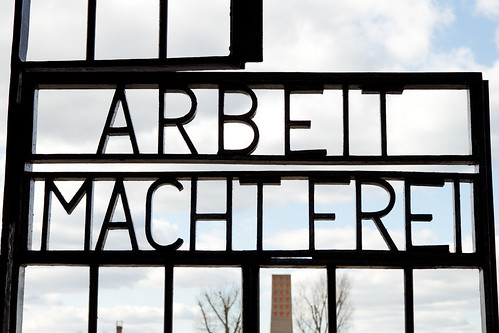
- "Arbeit macht frei" ("work sets you free"), the message in Sachsenhausen's entrance, among other concentration camps.

- Numbers and symbols assigned to Sachsenhausen prisoners.
From 1936 to 1945, over 200,000 people from all over Europe—criminals, Communists, gays, Jews, political opponents, Jehovah's Witnesses, anyone deemed racially or biologically inferior, and then some—were imprisoned at Sachsenhausen Concentration Camp, significant for being built as a prototype for other concentration camps (you can get a good look at its design in this map) and for being the closest concentration camp to Berlin at only 35 kilometers north in Oranienburg. An estimated 30,000 to 50,000 people died*, which to me sounds surprisingly low—even if Sachsenhausen wasn't an extermination camp, but a labor camp—considering all the numerous and easy ways people could die there.
* Source; I've also read the death toll as being around 100,000, but some sources call that an overestimation.
Out of all those ways—starvation, disease, exhaustion, horrific medical experimentation, gas chamber, hanging, shooting—the one that stood out to me the most was "getting shot in the neck while thinking you're just get your height measured during a medical check up." The height gauge used for such executions is in the photo above. Here's a description of how the device was used, from former commandant of Sachsenhausen Anton Kaindl at his trial:
Until mid of 1943, prisoners were killed by shooting or hanging. For the mass exterminations, we used a special room in the infirmary. There was a height gauge and a table with an eye scope. There were also some SS wearing doctor uniforms. There was a hole at the back of the height gauge. While a SS was measuring the height of a prisoner, another one placed his gun in the hole and killed him by shooting in his neck. Behind the height gauge there was another room where we played music in order to cover the noise of the shooting.

- Execution trench.
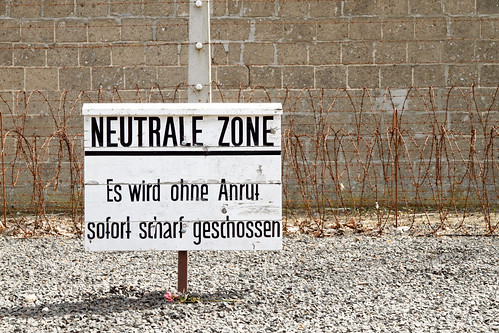
- Neutrale Zone: Es wird ohne Anruf, sofort scharf geschossen. Translates to something like, "You'll be immediately shot at without warning."
Considering the Schutzstaffel (SS) had no problem killing people in the execution trench, or shooting prisoners who dared enter the not very neutral-sounding "Neutrale Zone" that encircled the camp, or [insert 20 other crimes against humanity], the execution-by-height-gauge practice seemed oddly indirect and...inefficient.
But our excellent Sandeman's tour guide Paul explained that the SS actually did have a problem killing people. Some of the members, at least—they couldn't psychologically handle killing people, face to face. The height gauge method made it easier. The killer couldn't see the prisoner, and the prisoner didn't know what was coming. Of course, there's still that knowledge that you're killing unassuming person after person after person, but I guess that was easier to get used to. (Although I'm sure a source is out there, I had trouble finding an official source that better described how the height gauges were used. This Tumblr post explains it pretty well.)
In 1942, Station Z was built to hold a crematorium, a morgue, and an area to shoot prisoners in (I think the height gauge was also used here, but I'm not sure); the next year, a gas chamber was added to the building. Most of Station Z is in ruins—effectively presented by a semi-translucent white enclosure that feels simultaneously confined and open in a way that helps take away the gloom—but you can see the general floorplan, like the edges of the gas chamber (before/after photo here) and the skeletal remnants of the cremation ovens.
Soviet and Polish soldiers liberated the camp on April 22, 1945. As you can see from the overbearing obelisk pictured above, built as part of the GDR-made memorial inaugurated in 1961, they didn't want anyone to forget it. (I can't find a source for this info, but Paul may have mentioned that the memorial was built crazy tall—about 40 meters—to overtake Tower A, the entrance to the camp.) How goes the memorial fail? Let me count the ways, part 1: The obelisk features 18 red triangles near the top of each of the obelisk's three sides representing the political prisoners' countries of origin—not so subtly ignoring Jews, homosexuals, and any other group of prisoners. Part 2: The statue in front (designed by René Graetz) features some rather healthy-looking, decently dressed prisoners about to be embraced by a soldier and his cozy liberation blanket. It's an unconvincing, self-serving portrayal considering the 3,000 prisoners left at the camp—two days prior, 33,000 prisoners had been evacuated and sent on a death march—probably looked more like this:

- Memorial in memory of the victims of Sachsenhausen Concentration Camp. Sculpture by Waldemar Grzimek.
You can read more about the problematic development of the 1961 Sachsenhausen Memorial at the official Sachsenhausen Memorial and Museum website and in the book The Claims of Memory: Representations of the Holocaust in Contemporary Germany and France.
As for what happened before 1961, the camp got a second wind from 1945 until 1950 when the Soviet secret service (NKVD) re-purposed Sachsenhausen as Soviet Special Camp No. 7 / No. 1 to detain political prisoners (functionaries of the Nazi Party, German P.O.W.s, and others). Out of the over 60,000 prisoners who passed through the camp, about 12,000 died due to illness and malnutrition.
There's absolutely no way I can recount all the information I heard on the tour or research all the camp's history for this post...so I'll just show you other photos I took.

- Tower A, the entrance to the camp's main area.

- Exhibition inside one of the barracks.

- Prisoners' wash-up area inside one of the barracks.

- Sleeping quarters.

- Hanging posts for torturing prisoners.

- Former prison cells from the prison used by the camp and the Gestapo.


- Inside some of the cells.
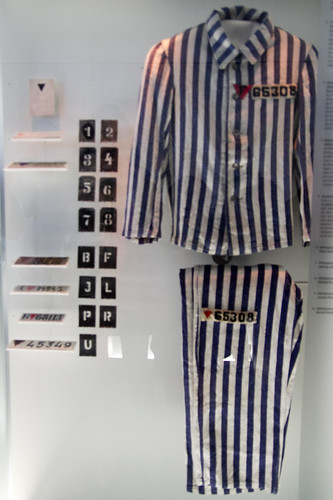
- The uniform.
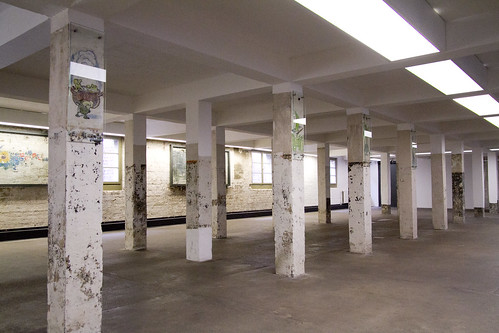
- The kitchen cellar.


- Two of many drawings on the cellar walls by German animator Hans Fischerkösen, who was imprisoned in the Soviet special camp.

- Tour group members and our guide, Paul. Behind him is the site of the former SS training grounds—and today, a training academy for the Brandenburg police force. This may seem inappropriate, but maybe it's a good thing to train policemen next to a concentration camp as a constant remind of what not to do ever.
The tour lasted three hours at the site (about five hours counting travel; bring lunch with you unless you want to be super hungry when you get back to Berlin), but you could spend much more time there if you want to look closely at the exhibits and museums, something the tour doesn't allot for—not a big loss though since Paul gave us plenty of detailed information.
The Sandeman's tour costs €15 (I bought tickets online, but it's easier to just buy 'em at the meeting spot), not counting the train ticket (if you already have an unlimited ticket like I did, you're best off letting your guide help you buy the right supplementary ticket instead of figuring it out yourself), and it's definitely worth it. The Sachsenhausen Memorial and Museum is also offering tours by donation [PDF] until September 30. Entrance to the memorial and museum is free, but I think you'd get much more out of it with a guide.
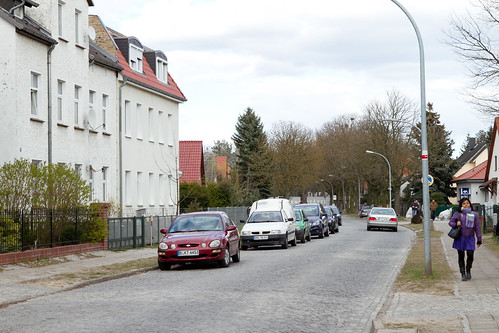
- The street leading up to Sachsenhausen. Cute little houses galore.

- Sachsenhausen entrance. [Photograph: mrbenr on Flickr]
Diana, Kåre, and I hadn't planned on visiting Sachsenhausen before our trip; we (at Diana's suggestion) only decided to go after our "free tour" guide had recommended it. AND THUS I PASS THE RECOMMENDATION ON TO YOU! ...The recommendation to learn about a horrific, deeply disturbing period in history. It's very much worth your time. You won't forget it.
Related
Berlin, Day 1: Dessert for Lunch, Sandwich for Snack, Schnitzel for Dinner
Berlin, Day 2: Three-Hour Guided Tour, Ice Cream at Fräulein Frost, and Dinner at Hasir
Berlin, Day 3: Computer Game Museum, Ostpaket, Humboldt Box, Berlin's Oldest Restaurant, DDR Museum
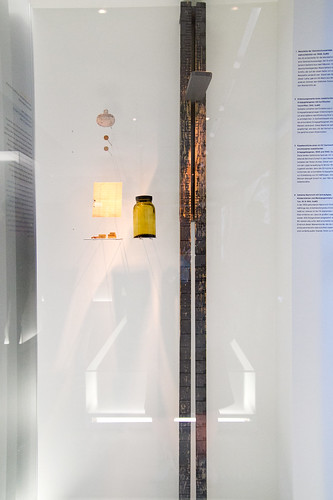

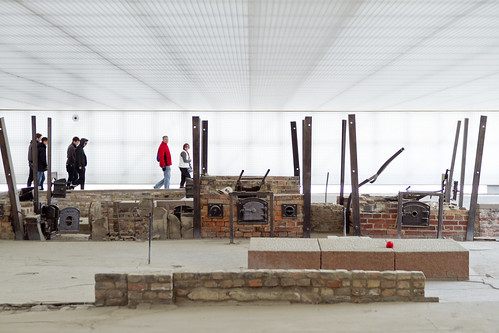


Comments
Hard to read. Probably hard to write. Thank you. I'm glad you wrote it.
Anonymous: Thank you for reading! Researching this post made for some...gloomy alone time in front of my computer, safe to say. But I'm glad to have learned so much. And it reminds me how incredibly easy my life is.
THANK YOU Robyn for this post.
YOur photographs communicate something special here - the austerity, the cruelty, the vast organization of this place, the utter coldness.
A very brave post to put up.
I have not been yet.
Daunting.
PB: Thanks for reading! I'm afraid that I may have left out too much emotion when I wrote this post, but the photos convey more than my words could.